Weeds for Dinner: Stinging Nettle Pasta
The Science and a Recipe
I was focused on using the water spigot and I did not pay attention to what was growing beneath. Ouch. I was thankful that it was me that found the Stinging Nettle and not my son who uses this spigot for many things. I asked if he knew what the plant was growing beneath it and he did not. I barely touched it; a small child would be in misery like no other.
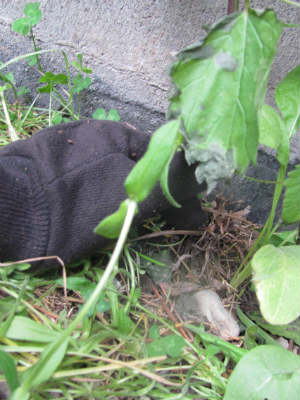
What is Stinging Nettle? This perennial plant is also called Urtica Dioica and if you have ever been as unfortunate as I had been to find it in this manner you probably already know why it is called Stinging Nettle.
Do you know what to do if you get the associated rash, the burning, or itching from Stinging Nettle? The cure for Stinging Nettle that we use if we are around the house (the best method I have found) is warm water and baking soda, blended into a thick paste and apply to the site.
You may not always have that luxury though; if you are out in a field with baking soda out-of-reach, try splitting open the stem of a dandelion and cooling the burn with the “juice”. This is an excellent remedy for any minor cut or mild skin irritation while in the field, until you can get home and do something more effective. If the injury is on a finger, it’s easy to “tie” the dandelion stem into a bandage around the finger. Some people say to “spit on it” because human saliva can begin to break down the acidic formic acid (which is the same thing fire ants have) and it dilutes it if nothing else, but honestly—I do not find this works with any noticable effect at all.
Because of young children playing, I would prefer that no stinging nettle grew in my yard immediately around the house. Stinging Nettle does pull nutrients up from deep within the soil, so I will keep my complaints to a minimum. Since I have it, I need to make use of it. I looked it up in my “Prescription for Nutritional Healing” guide and I found that it is full of phytochemicals such as:
acetic acid beta-carotene
betaine caffeic acid
ferulic acid lecithin
lycopene p-coumaric acid
scopoletin
Here’s a list of nutrients:
calcium copper fatty acids
folate iron magnesium
manganese phosphorus potassium
selenium sulfur zinc
and the vitamins B1, B2, B3, B5, C, and E
WOW—what a list! It is used for a crazy list of ailments, basically due to the high level of nutrients in this plant. Anything from allergies to inflammatory conditions, hair care products (because it helps stimulate hair follicles and regulates scalp oil buildup), and it’s even used as a pain reliever. Pain reliever? Pain causer may be, I know this firsthand.
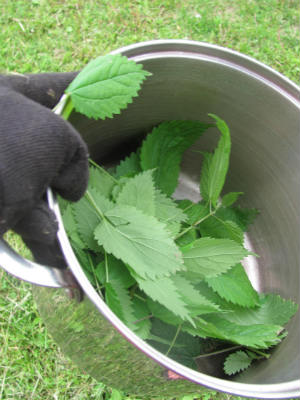
Trying to figure out what to do with my “electric grass”, I decided to go for cuisine instead of any medicinal applications this time. This much nutrition should not be lost to a slimy green that my kids refuse to eat! As with all nutritional greens, I slip them into a Stinging Nettle pasta and no one is the wiser.
I chose to make pasta with it and it was wonderful, try this Stinging Nettle recipe:
Step 1: Wearing work gloves, pull the Stinging Nettle from the bottom of the plant. Since it is a perennial, it will likely reappear next year. Pull a lot of it, as it shrinks like spinach when cooked.
Step 2: Boil for about 3-5 minutes. You can simply “wilt” it but I recommend more (for texture).
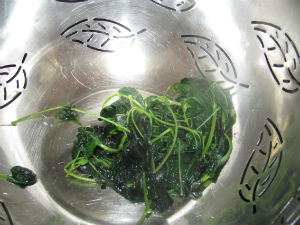
Step 3: Have a bowl of ice water ready to give it an ice bath; this preserves the vibrant color.
Step 4: Strain and wring out. Some people save the water for tea but I thought it tasted “grassy”.
Step 5: Set aside and use in recipes as desired. You could dehydrate it for future teas, pastas, casseroles etc.
Fettuccini Alla Carrettiera (Pasta with Onions & Bread Crumbs)
1 batch of Chaya’s basic pasta recipe
Fresh parsley
Onion
2 cloves
garlic (or substitute garlic salt, omitting salt)
1 ½ Tbs Oregano
Salt, Pepper to taste
1 cup Bread Crumbs (always keep your homemade bread scraps in freezer!)
Olive Oil
Step 1: While pasta is boiling, heat olive oil in large skillet with garlic, onion, and fresh parsley, until onions caramelized.
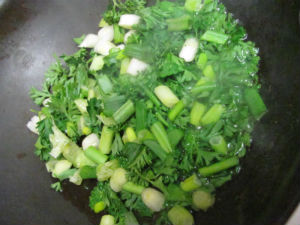
Step 2: (Add more olive oil if necessary). Add homemade bread crumbs to skillet until slightly browned.
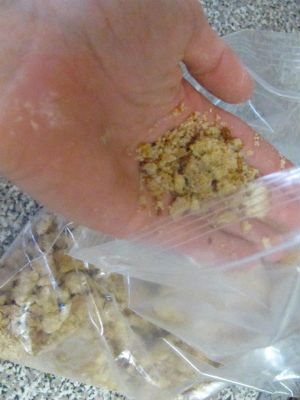
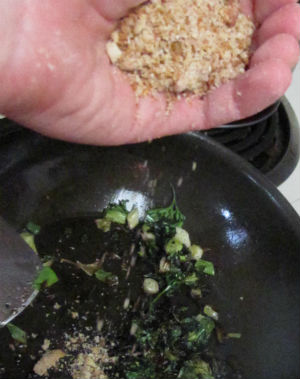
Step 3: Drain finished pasta and dump into skillet, sautee’ for approximately 2 minutes, stirring, until pasta absorbs the flavors.
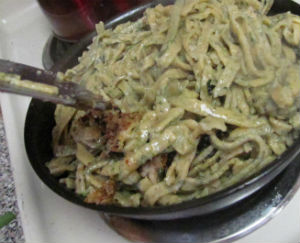
Serve with a sprig of fresh parsley.
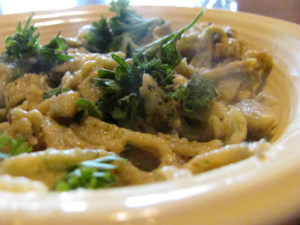
Enjoy! Leave a comment to let me know how you like it.
–Chaya
P.S. Here is a video recipe from our friend Paul Wheaton over at Permies.com on making stinging nettle pasta (lasagna):
Sources:
Balch, P. (2006). Prescription for nutritional healing. (4 ed.). New York, NY: Avery.
All photos by Pantry Paratus
Proviso:
Nothing in this blog constitutes medical advice. You should consult your own physician before making any dietary changes. Statements in this blog may or may not be congruent with current USDA or FDA guidance.
We respect Your Privacy.
